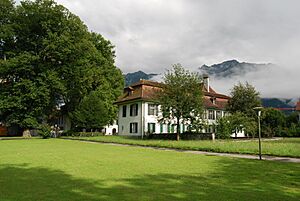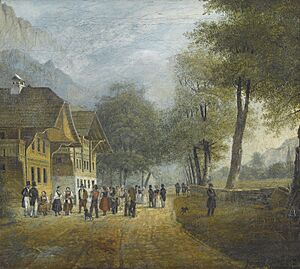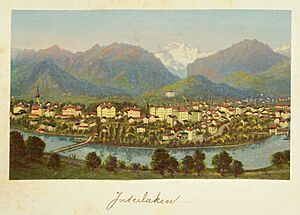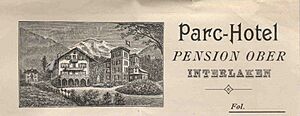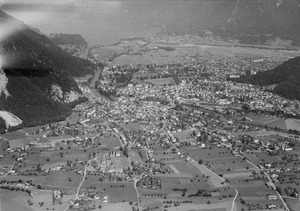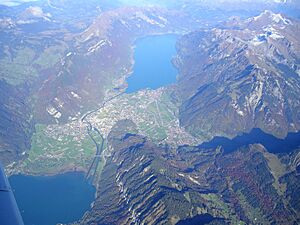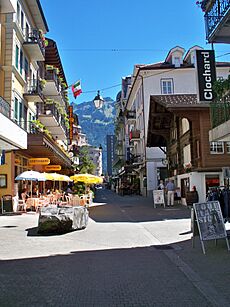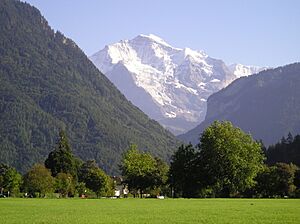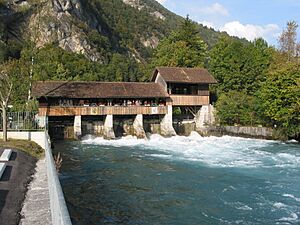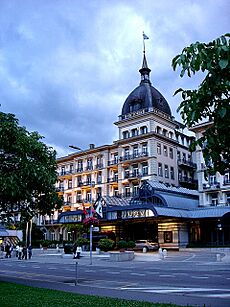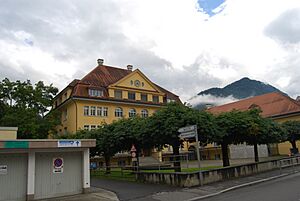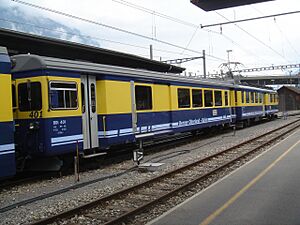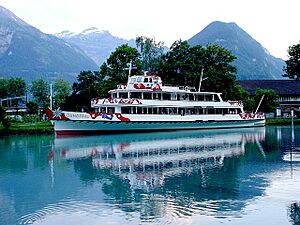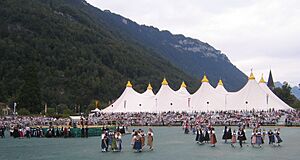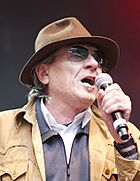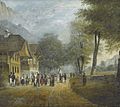Interlaken facts for kids
Quick facts for kids
Interlaken
|
||
|---|---|---|
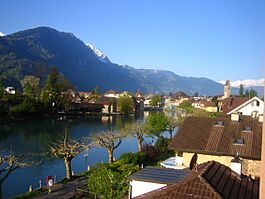
Interlaken
|
||
|
||
| Country | Switzerland | |
| Canton | Bern | |
| District | Interlaken-Oberhasli | |
| Area | ||
| • Total | 4.27 km2 (1.65 sq mi) | |
| Elevation
(Convent/Castle)
|
568 m (1,864 ft) | |
| Population
(Dec 2020 )
|
||
| • Total | 5,719 | |
| • Density | 1,339.3/km2 (3,469/sq mi) | |
| Demonym(s) | German: Interlakner(in) | |
| Postal code |
3800
|
|
| Localities | Im Moos, Öli | |
| Surrounded by | Bönigen, Därligen, Matten bei Interlaken, Ringgenberg, Unterseen | |
| Twin towns | Scottsdale (USA), Ōtsu (Japan), Třeboň (Czech Republic) | |
Interlaken is a cool town in Switzerland. Its name means "between lakes" in Latin, which makes sense because it sits right between two beautiful lakes: Brienz to the east and Thun to the west. The Aare river flows right through the town, connecting these two lakes.
Interlaken is a super popular spot for tourists, especially those who love the mountains. It's like a main gateway to the amazing Swiss Alps and the stunning lakes in the Bernese Oberland area. From here, you can easily reach famous mountain peaks like Eiger, Mönch, and Jungfrau.
The town is built on flat land called Bödeli. While German is the official language, most people speak a local Swiss German dialect called Bernese German. Interlaken is the main town in a small group of towns with about 23,300 people living there.
Contents
History of Interlaken
Before 1891, Interlaken was actually called Aarmühle. The name "Interlaken" comes from a monastery built around 1133. This monastery was first mentioned as inter lacus Madon, meaning "between lakes."
Early Beginnings
Even though some old tools and Roman coins have been found, there's no real proof of a town here before the Middle Ages. The Interlaken Monastery was built around 1133 on land owned by the Holy Roman Empire. The monastery controlled a bridge over the Aare river and collected money from people who used it. A small village grew up around the monastery, and it even had a mill, which gave the area its old name, Aarmühle.
On the other side of the river, another village called Interlaken developed. Later, in 1279, the village of Unterseen also grew nearby. There was also an old castle, Weissenau, and a market town called Widen, but these fell apart over time.
The Interlaken Monastery
The Interlaken Monastery was first mentioned in 1133. By 1247, it had both monks and nuns. During the 1200s, the monastery became very powerful, owning many churches, villages, and farms. It was the biggest religious landowner in the area.
However, by the 1300s, the monastery faced problems. The number of monks and nuns went down, and they got into debt. In 1310, there were many people living there, but by 1472, there were far fewer. The monastery also had arguments with its tenants and neighbors.
Eventually, the monks and nuns stopped following many of their strict rules. In 1472, a big fight between the men's and women's parts of the monastery led to an investigation. The nun's part was closed in 1484.
When the Protestant Reformation happened in 1528, the monastery was closed down by the government of Bern. Its lands were then managed by a Bernese official called a bailiff. After this, part of the monastery building was used as the local government office, and another part became a hospital. In the 1700s, a new building called the New Castle was built on the site, and it's still used for local government today.
From Aarmühle to Interlaken
Aarmühle got its name from a mill on the Aare river, built around 1365. The monastery used to hold markets there. Aarmühle was part of the larger area of Matten.
Over time, Aarmühle and Matten had disagreements about shared land. In 1810, they finally divided their property. By 1838, Aarmühle became its own independent town. However, Aarmühle started using the name Interlaken for its post office and train station, which made that name much more famous. In 1891, the town officially changed its name to Interlaken.
The Rise of Tourism
Interlaken became famous as an international resort around 1800. Artists like Franz Niklaus König painted its beautiful landscapes, attracting many visitors. Festivals like the Unspunnenfest in 1805 and 1808 also brought in tourists. People started coming for the fresh mountain air and spa treatments. A large spa building, the Kursaal, opened in 1859.
Good transportation helped tourism grow. In 1835, steamships started running on Lake Thun, and in 1839, on Lake Brienz. Later, railways connected Interlaken to other towns and cities. The Bödelibahn railway opened in 1872, linking the steamships on both lakes. By 1893, a direct train line connected Interlaken to Thun and beyond. Eventually, you could even take a train all the way to Lucerne. In 1890, the Berner Oberland railway connected Interlaken to popular places like Lauterbrunnen and Grindelwald.
With better transport, many fancy hotels were built, especially between 1860 and 1914, offering great views of the Jungfrau and other mountains. The current Kursaal building was built around this time too.
Even though tourism was big, Interlaken also had some factories, like a parquet factory and a wool weaving factory. Since 1988, Interlaken has been connected to the A8 motorway, making it easier to reach by car.
Modern Interlaken
The two World Wars caused tourism to slow down a lot. But after 1955, Interlaken started to recover by becoming a center for conventions and conferences. Today, the old villages of Aarmühle and Interlaken have grown together with new buildings. The nearby towns of Matten and Unterseen are also connected to Interlaken, sharing many services.
Geography
Location and Landscape
Interlaken is located about 566 meters (1,857 feet) above sea level. It sits on flat land called Bödeli, right between Lake Brienz to the east and Lake Thun to the west. As its name suggests, the town is truly "between lakes." The Aare river flows right through Interlaken, connecting these two lakes. Another river, the Lütschine, flows from the mountains into Lake Brienz, but it doesn't go through Interlaken itself.
Interlaken covers an area of about 4.27 square kilometers (1.65 square miles). About 24.4% of this land is used for farming, and 22.6% is covered by forests. A large part, 47.2%, has buildings or roads. About 7% is rivers or lakes.
Climate
Interlaken has a mild climate. It gets enough rain all year round, and the temperatures don't change too much between the highest and lowest points.
| Climate data for Interlaken (Reference period 1991–2020) | |||||||||||||
|---|---|---|---|---|---|---|---|---|---|---|---|---|---|
| Month | Jan | Feb | Mar | Apr | May | Jun | Jul | Aug | Sep | Oct | Nov | Dec | Year |
| Mean daily maximum °C (°F) | 3.2 (37.8) |
5.4 (41.7) |
10.5 (50.9) |
14.7 (58.5) |
18.7 (65.7) |
22.4 (72.3) |
24.3 (75.7) |
23.7 (74.7) |
19.2 (66.6) |
14.1 (57.4) |
7.8 (46.0) |
3.7 (38.7) |
14.0 (57.2) |
| Daily mean °C (°F) | 0.0 (32.0) |
1.0 (33.8) |
5.2 (41.4) |
9.2 (48.6) |
13.3 (55.9) |
16.9 (62.4) |
18.6 (65.5) |
18.1 (64.6) |
14.1 (57.4) |
9.6 (49.3) |
4.2 (39.6) |
0.8 (33.4) |
9.3 (48.7) |
| Mean daily minimum °C (°F) | −2.8 (27.0) |
−2.5 (27.5) |
0.9 (33.6) |
4.1 (39.4) |
8.3 (46.9) |
12.1 (53.8) |
13.8 (56.8) |
13.6 (56.5) |
10.0 (50.0) |
6.0 (42.8) |
1.2 (34.2) |
−1.8 (28.8) |
5.2 (41.4) |
| Average precipitation mm (inches) | 72 (2.8) |
67 (2.6) |
73 (2.9) |
82 (3.2) |
122 (4.8) |
127 (5.0) |
146 (5.7) |
146 (5.7) |
94 (3.7) |
80 (3.1) |
80 (3.1) |
91 (3.6) |
1,178 (46.4) |
| Average snowfall cm (inches) | 28.1 (11.1) |
26.5 (10.4) |
11.4 (4.5) |
0.8 (0.3) |
0.0 (0.0) |
0.0 (0.0) |
0.0 (0.0) |
0.0 (0.0) |
0.0 (0.0) |
0.0 (0.0) |
5.6 (2.2) |
17.8 (7.0) |
90.2 (35.5) |
| Average precipitation days (≥ 1.0 mm) | 9.1 | 8.5 | 9.9 | 10.1 | 12.5 | 13.2 | 12.8 | 12.8 | 9.5 | 9.3 | 9.6 | 10.0 | 127.3 |
| Average snowy days (≥ 1.0 cm) | 4.6 | 4.7 | 3.1 | 0.4 | 0.0 | 0.0 | 0.0 | 0.0 | 0.0 | 0.0 | 1.1 | 3.2 | 17.1 |
| Average relative humidity (%) | 83 | 78 | 72 | 69 | 72 | 73 | 73 | 77 | 80 | 83 | 84 | 85 | 77 |
| Mean monthly sunshine hours | 67 | 82 | 129 | 164 | 183 | 200 | 223 | 199 | 152 | 102 | 68 | 56 | 1,625 |
| Percent possible sunshine | 41 | 49 | 49 | 48 | 44 | 46 | 52 | 53 | 53 | 50 | 42 | 36 | 48 |
| Source: MeteoSwiss (snow 1981–2010) | |||||||||||||
People and Population
Interlaken has a population of about 5,800 people. In 2010, about 26.4% of the people living there were from other countries. Over the past 10 years, the population has grown by about 5.3%.
Most people in Interlaken (about 83.4%) speak German as their main language. Portuguese is the second most common language, and Italian is third.
In 2008, about 47.5% of the population was male and 52.5% was female. Many people who live in Interlaken were born there or in the same region of Switzerland.
The population has changed over time, as shown in this chart:

Religion in Interlaken
In 2000, about 56.1% of the people in Interlaken belonged to the Swiss Reformed Church (Protestant), and 22.3% were Roman Catholic. There were also smaller groups of other Christian churches, as well as people who were Islamic, Buddhist, Hindu, or had no religion.
Economy and Jobs
Interlaken is known as a tourist town. In 2014, there were almost 7,000 jobs in the town. Most of these jobs (over 6,000) were in the service industry, which includes things like hotels, restaurants, shops, and transportation. About 800 jobs were in the manufacturing and construction industries. Only a few jobs were in the farming industry.
In 2015, hotels in Interlaken had over 710,000 overnight stays, and most of these visitors (82.2%) were from other countries. In 2017, there were about 27 hotels with over 1,500 rooms. A large number of jobs in Interlaken are in hotels and restaurants.
Tourism and Attractions
Interlaken is a great place to start exploring the beautiful areas around it.
Mountain Adventures
One of the biggest draws is the Jungfrau region, with its towering mountains like the Jungfrau (4,158 meters or 13,642 feet), the Mönch (4,107 meters or 13,474 feet), and the Eiger (3,967 meters or 13,015 feet). While climbing these peaks is for experienced mountaineers, you can take a series of connecting mountain railways all the way up to the Jungfraujoch. This is a saddle (a low point between two peaks) at 3,454 meters (11,332 feet), and it's the highest point in Europe you can reach by train!
Closer to Interlaken, you can also take a funicular railway up to the Harderkulm (1,321 meters or 4,334 feet) or the Schynige Platte (1,967 meters or 6,453 feet). Both offer amazing views of the higher mountains and the lakes below.
Lakes and Rivers
Lake Thun and Lake Brienz are both very close to Interlaken. The Aare river flows right through the town, connecting these two lakes. You can take boat trips on both lakes, visiting different towns along the shores. From Brienz, you can even ride one of Switzerland's last remaining steam-powered mountain railways, the Brienz Rothorn Railway.
Fun for Everyone
Just south of Interlaken, you'll find Jungfrau Park, an amusement park. It first opened as Mystery Park, a theme park about paranormal topics, but it closed down for a while. It reopened in 2009 with its current name and focus.
Interlaken has many hotels, from fancy ones to places for backpackers. Many hotels are along the Höheweg, a street that connects the town's two train stations and offers great mountain views. For backpackers, there are also companies that offer guided activities like skydiving, canyoning, hang gliding, paragliding, and skiing.
Education
In the canton of Bern, where Interlaken is located, children usually start with one year of optional Kindergarten. After that, they go to six years of Primary school. Then comes three years of lower Secondary school, where students are grouped by their abilities. After lower Secondary, students can choose to continue their education or start an apprenticeship (learning a trade on the job).
During the 2009-2010 school year, about 667 students attended schools in Interlaken. This included 72 kindergarten students, 275 primary students, and 301 lower secondary students. Many students in Interlaken schools are from other countries or speak a different language at home.
Interlaken also has the Bödeli-Bibliothek library. In 2008, it had over 22,000 books and other media. It loaned out more than 114,000 items that year, showing how much people use it!
Transportation
Interlaken has two main train stations: Interlaken Ost (East) and Interlaken West. Both stations are served by trains that connect to Spiez, Thun, Bern, and other parts of Switzerland. You can even find international trains like the TGV to Paris and ICE to Frankfurt and Berlin.
Interlaken Ost is a very important station. It's where the Zentralbahn's train line to Brienz, Meiringen, and Luzern begins or ends. It's also the starting point for the Berner Oberland railway, which takes you into the Jungfrau region and towards the famous Jungfraujoch.
You can also take boat trips on the lakes. Boats on Lake Thun leave from a dock near Interlaken West station. Boats on Lake Brienz leave from a dock on the Aare river near Interlaken Ost station.
For road travel, Interlaken is connected to the A8 motorway, which links to Thun and Lucerne. Local roads also run along the lakes and into the Jungfrau valley.
In the immediate area, two special railways called funiculars can take you up to nearby viewpoints: the Harderbahn and the Heimwehfluhbahn. Local and regional buses are also available to help you get around.
Culture and Events
Interlaken hosts several exciting events:
- The Jungfrau Marathon is a big running race held in Interlaken every September.
- The Unspunnenfest is a special festival that happens about every twelve years. It celebrates traditional Swiss culture with cool competitions like Steinstossen (stone throwing), Schwingen (Swiss wrestling), and yodelling. The last one was in 2017, and the next is planned for 2029.
- During the summer, the Greenfield Festival takes place just outside Interlaken, bringing music and fun.
- In 2007, the Red Bull Air Race World Series was held at the airport near the town.
Important Buildings
Some buildings in Interlaken are considered very important national heritage sites. These include the old Monastery Building, the Hotel Royal-St. Georges, the Hotel Victoria-Jungfrau, and the Kursaal. The entire old village area of Interlaken is also recognized as a special Swiss heritage site.
Notable People
Many interesting people have lived in or come from Interlaken:
- Marie Fillunger (1850–1930), an Austrian singer who lived in Interlaken.
- Georgia Engelhard (1906–1985), an American mountaineer, painter, and photographer who lived here.
- Hans Schaffner (1908–2004), a politician who was a former Federal Councillor (a high-ranking government official).
- Dölf Reist (1921–2000), a photographer and alpinist (mountain climber).
- Adrian Frutiger (1928–2015), a famous typographer (someone who designs fonts), who did his apprenticeship in Interlaken.
- Elisabeth Glauser (born 1943), a Swiss opera singer and voice teacher.
- Polo Hofer (1945–2017), a well-known Swiss rock musician.
- Sports Stars
- Walter Balmer (1948–2010), a Swiss international footballer.
- Suzanne Müller (born 1963), a Swiss rhythmic gymnast who competed in the 1984 Summer Olympics.
- Sandra Dombrowski (born 1967), a Swiss ice hockey player and referee.
- Nelson Ferreira (born 1982), a Swiss and Portuguese footballer.
- Marcel Marti (born 1983), a Swiss ski mountaineer.
- Sven Michel (born 1988), a Swiss curler.
- Kilian Moser (born 1988), a racing cyclist.
- Sascha Stulz (born 1988), a Swiss professional football goalkeeper.
- Lucas Tramèr (born 1989), a Swiss rower who won a gold medal at the 2016 Summer Olympics.
Images for kids
See also
 In Spanish: Interlaken para niños
In Spanish: Interlaken para niños






